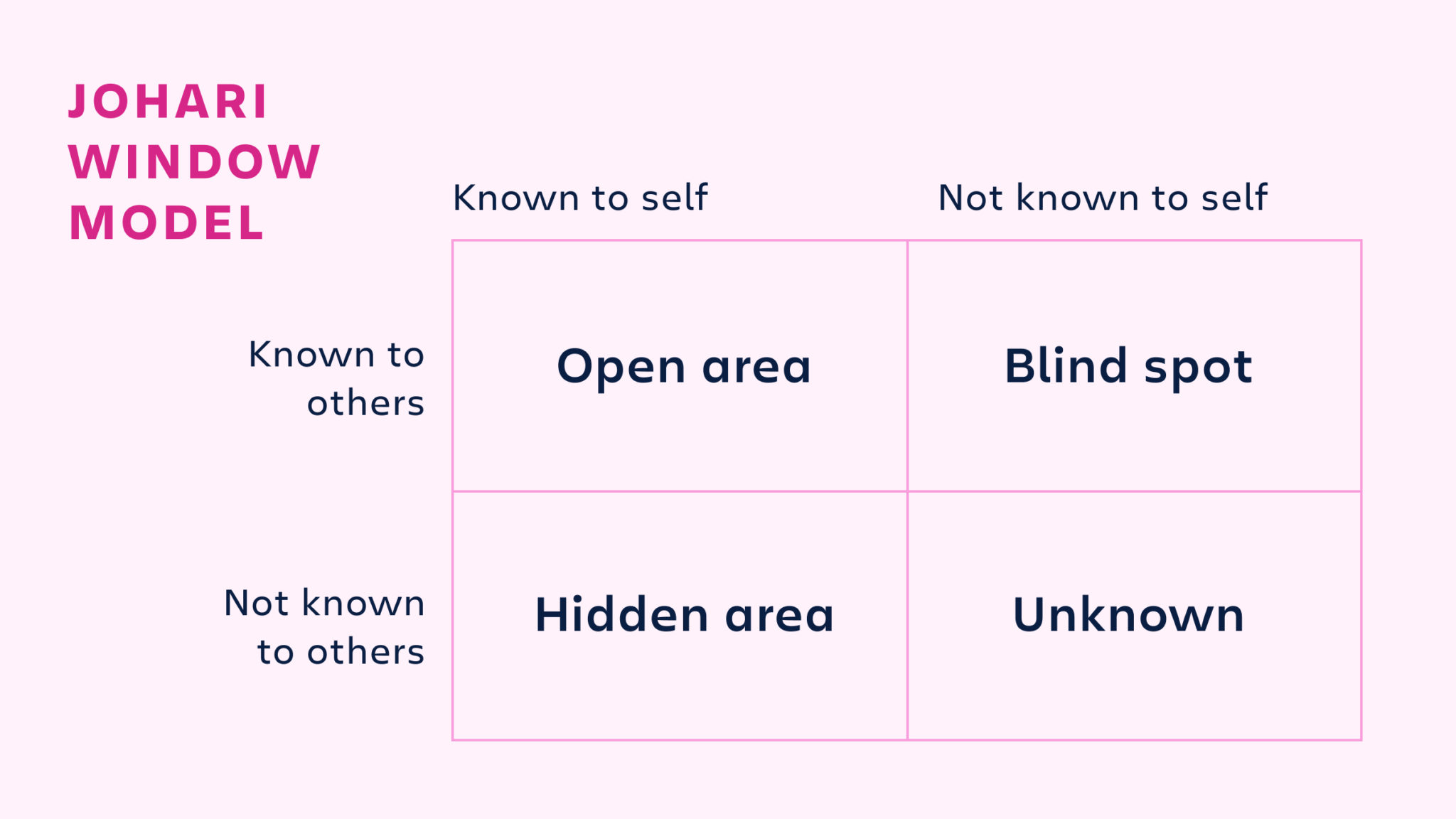5-second summary
- Not to be confused with interpersonal communication, which is between two or more people, intrapersonal communication is communication with oneself. Think of it as the voice inside your head.
- Experts have found that positive intrapersonal communication helps us feel better physically and mentally, which can contribute to better performance at work.
- Like any other skill, we can take intentional steps to improve our intrapersonal communication, which helps us become our best selves and better teammates.
Picture this: You’re preparing for a big meeting to present your ideas for a new project. Your heart starts to beat faster, and negative thoughts begin creeping in. “Last time, your boss asked questions that you didn’t know the answer to. You clearly aren’t cut out for this kind of project!”
Then, your inner cheerleader speaks up: “But her questions actually made you think, and after you did more brainstorming, she really liked what you presented. You got this!” Hopefully, that personal pep talk gets you in the right headspace, and your boss loves your ideas!
This is a prime example of how intrapersonal communication (not to be confused with interpersonal communication) can affect our daily lives, for better or worse. Being hard on ourselves often leads to stress, sadness, and poor coping skills, while thinking positively is proven to boost mental wellness, physical health, and work performance.
It may seem like we can’t control how we think or talk to ourselves – our self-talk is such a reflexive aspect of our thought processes, it can feel completely involuntary. But if we treat intrapersonal communication as a skill (which it is) rather than a personal thought process, it’s a lot easier to see ways to improve. Here’s how.
What is intrapersonal communication?
Unlike interpersonal communication, which is exchanged between two or more people, intrapersonal communication is communication with oneself. There are many other names for the same concept – self-talk, internal monologue, inner speech, inner experience, and internal discourse. They all describe pretty much the same concept: the voice inside your head.
Although intrapersonal communication mostly occurs internally, it can be voiced out loud (e.g., talking to yourself, rehearsing, audibly recalling a piece of information) or via the written word (e.g., journaling, note-taking, or writing in a diary).
Regardless of the medium, intrapersonal communication shows up in many situations inside and outside of work: planning, problem-solving, conflict resolution, evaluation, judgments, and more. While everyone experiences it in different ways, it’s the way we use our inner voice that determines how it impacts our lives and livelihoods.
How intrapersonal communication can help or hurt
Almost all of us have an inner monologue, but according to intrapersonal communication expert Russell Hulburt, it’s “a frequent thing for 30 to 50 percent of people.”
did you know?
Some people actually don’t have an inner monologue – rather than “hearing” their thoughts as dialogue in their heads, they process ideas in an abstract, non-verbal way. Pretty mind-blowing for those of us whose brains spout nonstop verbal narrative throughout the day.
Some people don’t pay too much attention to their inner voice, while others listen carefully and often talk through situations in their heads as they process information. Some have a more positive, optimistic monologue, while others struggle with negative thoughts, like perfectionism, self-blame, and imposter syndrome.
It’s common and perfectly normal to experience both sides of that coin – it’s how we handle the negative thoughts that make the difference. In this instance, it’s no different than communicating with others. When we give colleagues feedback, we choose our words carefully to be encouraging and constructive, rather than harsh or shameful, because we know being optimistic builds healthier relationships and better performance. So why don’t we take the same approach when communicating with ourselves?
Dwelling on the negative can pose several health risks and hold us back at work while shifting to more positive intrapersonal communication leads to a number of powerful benefits.
| Benefits of positive self-talk According to experts at The Mayo Clinic | Risks of negative self-talk According to experts at BetterUp |
| Better coping skills during times of hardship and stress | Chronic stress |
| Better psychological and physical well-being | Poor mental health |
| Increased life span, better cardiovascular health, and reduced risk of death from cardiovascular disease | Low quality of life |
| Lower rates of depression and distress | Low self-esteem |
When we feel better physically and mentally, we do a better job at work. Studies show that positive self-talk improves performance (especially during stressful or risky moments like big meetings), increases focus, lower anxiety, and more empathetic relationships with colleagues. It’s no coincidence that many of the successful leaders and high performers around us are those who have a strong sense of self and effective communication skills, both with themselves and with others.
4 exercises for more effective intrapersonal communication at work
Although it may feel like we can’t control the voices in our heads, we actually can strengthen our intrapersonal communication just like any other professional skill. It takes self-awareness, honest reflection, and methodically rewiring some of the ways we typically think, but it is possible. By changing the way we think, we can change the way we feel and how we show up at work and in life. (This is the essence of cognitive behavioral therapy.)
If you’re interested in reaping the benefits of better intrapersonal communication – especially at work – these exercises can help you assess your current skills and improve them for the future.
1. Self-witnessing
Replay in your mind a recent stressful situation at work when you used positive self-talk, such as hyping yourself up before a big presentation. Then, think of a different time when your inner voice was more self-conscious or negative, like saying to yourself, “That was such a careless mistake. You really should have known better.”
As you’re “witnessing” these scenarios, here are a few questions to think about:
- Did the self-talk happen automatically, or was it purposeful?
- How did you feel when those thoughts came to mind?
- What was the result of talking to yourself? Did the situation turn out positively or negatively?
- If it didn’t go well, what could you have done differently for a better outcome?
Reflecting on how self-talk has impacted our work in the past can help us be more aware when negative thoughts come up in the future and shift to the positive for better results.
2. Front-page headline
Just like developing a company or product vision informs a team’s strategy and keeps everyone moving in the same direction, envisioning where your career is headed – and “talking” it through with yourself – can help determine the steps you’ll take to get there.
So, close your eyes, and imagine an article is published about you in the future – perhaps one, five, or ten years from now. It highlights your accomplishments and the legacy you’re leaving for your team. What would the headline be?
Achieving this vision will likely require taking several steps and honing your skills. It’s common to focus on more tangible skills, like technical capabilities or leadership, but how might strengthening your intrapersonal communication help move you closer to your goals? Taking control of your inner voice could help overcome what’s been holding you back and give you the confidence needed to eventually get that front-page headline.
3. The Johari window
The Johari window is a team activity that can help a group get a better grasp on each person’s most prominent qualities, as well as the areas to improve.
To try this model, review a list of adjectives, and choose five or six terms that best describe you. Then, your colleagues would do the same, choosing the descriptors they think fit you best. Finally, plot each list on a four-quadrant matrix, which will look like a window with four panes (hence the “Johari window” moniker).

Sorting the adjectives into their appropriate quadrants uncovers what qualities both you and your colleagues agree that you possess, which ones they see but you don’t, and which ones you notice but they don’t pick up on. This information not only helps us make improvements, but also connects with our coworkers on a deeper level.
4. The triple-column technique
Self-talk techniques like this one developed by clinical psychiatrist Dr. David D. Burns, often in combination with other forms of therapy, have been found to be very successful at treating anxiety, anger, and stress.
Here’s how it works:
Once again, think of a recent work situation that caused you stress or sadness. (Seeing a trend here?) Then, make three columns on a sheet of paper or in a spreadsheet. In the first column, you’ll write down the “automatic thoughts” that came to mind in that situation – one statement per line or cell. Some of these will likely be negative thoughts, and that’s okay.
In the second column, you’ll write down the cognitive distortion in each of those statements – we’re sharing just a handful of them below.

Finally, in the third column, you’ll write your “rational response.” This would be the logical reply you would tell someone else who was experiencing the same thing, or what you would tell yourself if you were in a calmer, happier state.
Here’s an example:
“My team worked for two years toward the launch of a new product feature, and the first round of customer feedback had several complaints. We were so disappointed and frustrated.”
| Automatic thought | Cognitive distortion | Rational Response |
| “I knew they were going to complain. I should have spoken up more about my concerns.” | Should-thinking Catastrophizing | “No feature is going to be perfect right when it’s launched. Customers will always have feedback, and we can fix it.” |
| “I never should have taken this role. If they had someone with more product experience, this wouldn’t have happened.” | Blaming Magical thinking | “I contributed a lot to this product, and there are a lot of really experienced people around me who were involved too.” |
| “People hate the product now.” | Overgeneralizing Emotional reasoning | “There were only a handful of complaints in the feedback, along with several compliments. We can fix the bugs and add some ideas to the backlog for improvements.” |
By seeing how our automatic thoughts often become distorted, we can better recognize when they appear next time and shift to the rational response faster.
Here’s to being kind to ourselves today and becoming our best selves in the future
Many forms of psychology, coaching, and inspirational words of wisdom reinforce a similar concept: We are not responsible for our first thought, but we are responsible for our second thought, and our first actions.
It’s not easy to identify our biases or change the way we think. But by treating this challenge like any other important project and taking small steps over time, you can hone your intrapersonal communication skills, improve the way you think and feel, and walk into every situation knowing that you got this.





 )
) 







































